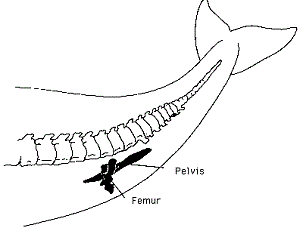On Saipan was discovered in about 1995 a blind cave spider. Cave divers have come through Micronesia collecting cave fauna, including blind cave shrimps. We had been studying an evolution video---The Evidence for Evolution---and I needed to explain vestigial structures, one of the evidences for evolution.
An article in Wikipedia about vestigiality.
A burning question is how a vestigial structure loses its functional morphology. Blind cave-dwelling organisms, for example, have eyes, but they are mere suggestions of the functioning eyes of their close allies. How does that happen? What pressures result in this diminution of an organ?
Darwin made some compelling arguments in On the Origin of Species, cited in the Wikipedia article noted above.
Examples of vestigial structures.
Here is a link to a Top Ten Useless Limbs and other vestigial organs, including the nipples of the human male.

The leg bones of a whale.
(found at
school.discovery.com/.../

Human Vestigial Structures -->
(found at
www.geology.ohio-state.edu/.
A blind lobste
 r was mentioned in the fascinating book Within the Deep found on Project Gutenberg: http://www.gutenberg.org/files/10617/10617-h/10617-h.htm. More recently is found a Wikipedia home page for a newly discovered deep sea hairy lobster, Kiwa hirsuta. The picture at left was found on that page.
r was mentioned in the fascinating book Within the Deep found on Project Gutenberg: http://www.gutenberg.org/files/10617/10617-h/10617-h.htm. More recently is found a Wikipedia home page for a newly discovered deep sea hairy lobster, Kiwa hirsuta. The picture at left was found on that page."The animal has strongly reduced eyes that lack pigment, and is thought to be blind."
A vestigial gene: (from http://www.bookrags.com/research/vestigial-structures-wap/)
"Vestigial structures may also be molecular, as in the case of vestigial genes that exist in most species. For example, although humans cannot manufacture their own vitamin C, most other mammals can because they possess a gene enabling them to produce an enzyme (L-gulono-gamma-lactone oxidase) which in turn makes it possible for them to produce vitamin C. Humans possess a defective copy of this gene that does not produce the required enzyme (or any other product). This gene was presumably disabled by mutation at a time in primate evolution when its loss was not a significant disadvantage, and now remains as a vestigial genetic sequence."
No comments:
Post a Comment